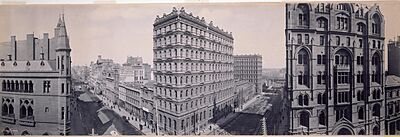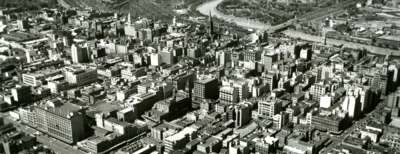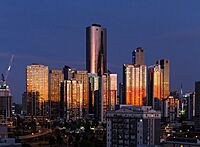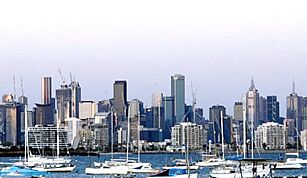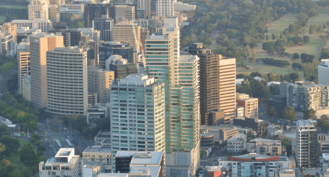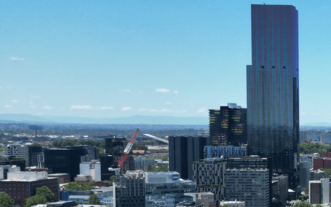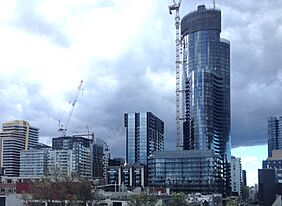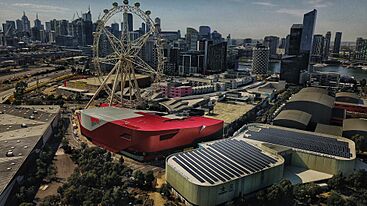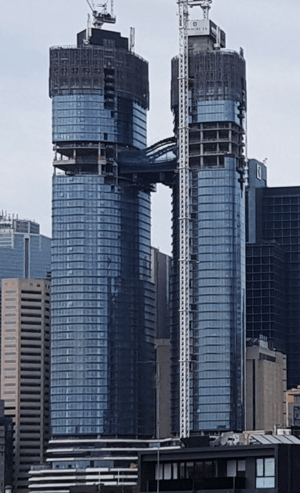List of tallest buildings in Melbourne facts for kids

Melbourne is home to approximately 758 completed high-rise buildings. Of those completed and or topped-out, 77 buildings are defined as "skyscrapers"–buildings which reach a height of at least 150 metres (490 ft); more than any other city in Australia. Overall, Melbourne's skyline ranks the tallest in the Oceania region and the 24th tallest in the world by the number of completed skyscrapers. Melbourne comprises five of the ten tallest buildings in Australia and the city has routinely hosted the tallest building in Australia to architectural feature or roof. As of 2024[update], the tallest building in Melbourne is the 100-storey Australia 108, which stands 317 metres (1,040 ft) in height and whilst the second–tallest building in Australia, it is the tallest to roof.
Geographically, most of Melbourne's tallest skyscrapers are concentrated in the City Centre precinct; however, other locations of prominent skyscrapers and tall buildings in Melbourne include Carlton, Docklands, Southbank, South Melbourne, South Yarra and St Kilda Road. The Melbourne central business district, defined by a grid of streets known as the Hoddle Grid, has a historically low central shopping area with high rise cluster in the western financial district, and another cluster in eastern end. Buildings are more densely packed in the west than the east, although the east has two of the city's tallest buildings to architectural feature—120 Collins Street and 101 Collins Street, respectively, whilst the Rialto Towers (located on the west side) is tallest by roof. In the 2010s, another skyscraper cluster rose in the northern section, with Aurora Melbourne Central the tallest.
Historically, Melbourne has represented several "firsts" and been the holder of various records, both in Australia and internationally. The city is notable for being one of the first cities in the world to build numerous tall office buildings, alongside New York City and Chicago in the United States, though Melbourne's first skyscraper boom was very short lived, 1888–1892. Melbourne was the location for Australia's first high–rise, the APA Building, constructed during this boom in 1889. Melbourne was also the location for the first modern post World War II high-rise in Australia, ICI House built in 1958. From 1986 to 2005, Melbourne's held the title of tallest building in Australia, with the Rialto Towers (1986–1991), 101 Collins Street (1991), and 120 Collins Street (1991–2005). Since 2006, the city has been home to the second-tallest building in the country, the Eureka Tower (2006–2020) and Australia 108 (2020–present); surpassed only by the Gold Coast's Q1, both the Eureka Tower, and later Australia 108, have maintained the title of tallest building in Australia to roof.
Contents
History and specifications

- 19th century
The late 1880s 'land boom' saw the construction of approximately a dozen 'lofty edifices' of 8 to 10 floors, made possible by the introduction of a pressurised hydraulic power network to operate lifts, and taking load bearing brickwork to great heights. The APA Building (Australian Building) at 12 floors plus spire, was by far the tallest, and can claim to be Australia's first 'skyscraper' and amongst the tallest building in the world when completed in 1889. Aside from the APA Building, a total of 11 'skyscrapers' were located in the Melbourne city centre during this period, including the Finks Building and 3 matching 'Prell's Buildings'. They were all built in an elaborate High Victorian style, with facades of stucco Renaissance Revival elements, except the APA building which was in red brick Queen Anne, prompting architectural historian Miles Lewis to comment that Melbourne had become a "Queen Anne Chicago". All except two were torn down in the post war boom of the 1960s and 1970s, with the APA controversially demolished in 1981.
- 20th century
Following much discussion, a 40-metre (130 ft) height limit was introduced to Melbourne in 1916, along with regulations concerning fire-proof construction. This height is often said to have been the limit of fire ladders at the time, but this was an idea that the then fire chief allowed to be widely circulated even though the tallest ladder rose to only 25 metres (82 ft), in order to ensure that fire safety was paramount. The main reasons for the limit, as well as fire proofing, were the preservation of light and air to the streets, avoiding congestion, and the influence of the City Beautiful movement, preferring evenly scaled streetscapes over those with buildings of varying heights. The height limit remained in force for nearly 40 years, allowing only uninhabited 'architectural features' to project beyond the 40 metre limit. The Manchester Unity Building (1932), for instance, achieved a total height of 64 metres (210 ft) to the top of its corner tower.
Melbourne was the first city in Australia to undergo a post-war high-rise boom beginning in the late 1950s, (though Sydney in the following decades built more) with over 50 high-rise buildings constructed between the 1970s and 1990s. ICI House (1955) was constructed after being granted a variation to the height limit; at a height of 81 metres (266 ft), the building was Australia's first modern high-rise. Its variation was on the basis that the design included an open garden space at ground level, introducing the concept of floor area ratio, where a total allowable floor area is used instead of a specific height limit. This was formalised by 'plot ratios' of 1:8 to 1:12 for different areas of the CBD in the "Borrie Report" in 1964, which was modified into a series of 'plot ratio benefit' scheme in the early 1980s, where the upper level of floor area could only be achieved in return for certain public benefits, such as a public arcade. Plot ratios remained in force for every site until 1999, when the 'New Format' Planning Scheme included plot ratios for entire city blocks rather than individual sites, a control that was mostly ignored.
In 1972, 140 William Street (formerly BHP House) became Melbourne's first building to surpass the height of 150 metres (490 ft), and thus, Melbourne's first "skyscraper". The William Street building was the city's tallest for a few years, and remains one of the few heritage registered skyscrapers in Melbourne. Slightly taller, the Optus Centre was completed in 1975; and then in 1977 Nauru House was crowned the tallest building in Melbourne, at a height of 182 metres (597 ft). In 1978, what would be the first of two Collins Place towers was opened, at a height of 188 metres (617 ft).
By the early 1980s, Melbourne had a total of 6 buildings above 150 metres (490 ft), with the completion of the Wentworth (later Regent then Sofitel) Hotel at Collins Place in 1980. In 1986, the Rialto Towers surpassed Sydney's MLC Centre as the tallest building not only in Australia but in the Southern Hemisphere, with a height of 251 metres (823 ft). At the time of its opening, it was the 25th–tallest building in the world. The 1990s brought Melbourne another 9 buildings over 150 metres (490 ft); 5 of which exceed heights of 200 metres (660 ft). Specifically, 1991 saw the construction of the 260-metre-tall (850 ft) 101 Collins Street, which was crowned the tallest building in Australia and the Southern Hemisphere; it was surpassed in height later that year with the completion of the nearby 120 Collins Street. The skyscraper, which stands at 266 metres (873 ft) in height, held the titles for tallest building in Australia and the Southern Hemisphere for fourteen years, until the completion of the Gold Coast's Q1 in 2005.
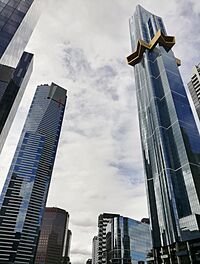
- 21st century
During the 2000s, over 20 high-rise structures were completed, including the Eureka Tower (2006), which overtook 120 Collins Street as the tallest building in Melbourne, and further became the second-tallest in Australia (although tallest to its roof). Eureka Tower was also the tallest residential building in the world to roof, until surpassed by Ocean Heights and the HHHR Tower in Dubai. It is currently the 15th-tallest apartment building in the world.
Construction trends significantly increased throughout the 2010s, which included the completion of Prima Pearl (2014) and Aurora Melbourne Central (2019), both of which exceed 250 metres (820 ft) in height. Throughout the decade, the city experienced an "unprecedented" skyscraper construction boom, with 22 skyscrapers constructed between 2010 and 2019. This feat had been described as the "Manhattanization of Melbourne".
During this period, new towers in the CBD had average plot ratios of 37:1. In September 2015, the Minister for Planning, Richard Wynne, introduced a 12-month height limit of approximately 229 metres (751 ft) for all buildings proposed in the Melbourne central business district and segments of Southbank, along with interim planning laws that re-introduced a floor area ratio of 18:1, which could be exceeded up to a maximum of 24:1 only with the provision of certain public benefits. Should projects exceed the plot ratio, developers will need to make a special case to the Minister, outlining the proposal's state significance. These controls were made permanent in September 2016. Buildings proposed prior to September 2015, such as Australia 108, which has a plot ratio of 46.6:1, were exempt from the new law.
The beginning of the 2020s saw the completion of Australia 108, which surpassed Eureka Tower as the tallest building in Melbourne and the tallest building in Australia to roof in 2020. It also became the Southern Hemisphere's first skyscraper to comprise at least 100 floors, and Melbourne's first building to be defined as a "supertall" skyscraper (buildings between the heights of 300 metres (980 ft) to 599 metres (1,965 ft)). In 2021, 12 skyscrapers were completed in the city— five more than the previous peak in 2020, and more than double prior peaks in 2017, 2005, and 1991. Among the tallest built in 2021 were West Side Place Tower A and Queens Place North Tower, both of which exceed 250 metres (820 ft) in height. Of future skyscrapers, 6 have topped-out, 7 are under-construction, over 20 have received approval, and another few have been proposed. The tallest of these is the currently approved dual-skyscraper project STH BNK by Beulah. Tower 1 will rise to 354 metres (1,161 ft) in height —supplanting Australia 108 as the tallest building in Melbourne and Q1 as the tallest building in Australia— whilst Tower 2 will rise to 273 metres (896 ft), taller than any other completed building in Australia outside of Melbourne and the Gold Coast.
The proliferation of skyscrapers in Australia over the past decades has also contributed to the city rivalry between Sydney and Melbourne. Whilst the first skyscraper in Australia was constructed in Sydney in 1967 (Australia Square), Melbourne has had the most skyscrapers in the country and indeed within Oceania, for over 35 years in total; from 1972 to 1989 (equal first with Sydney during 1972–74 and 1976–77), from 1991 to 1999, in 2006 (shared with Sydney), and again since 2015 (equal to Sydney from 2015 to 2016).
Precincts
| Precinct of Melbourne |
C | T-O | U-C | O–H | A | P |
|---|---|---|---|---|---|---|
| Carlton | 1 | 0 | 0 | 0 | 0 | 0 |
| City Centre | 58 | 0 | 3 | 0 | 7 | 2 |
| Docklands | 1 | 0 | 1 | 0 | 1 | 0 |
| Port Melbourne | 0 | 0 | 0 | 0 | 1 | 0 |
| Southbank | 15 | 0 | 1 | 0 | 12 | 3 |
| South Melbourne | 0 | 0 | 0 | 0 | 3 | 0 |
| South Yarra | 1 | 0 | 0 | 0 | 0 | 0 |
| St Kilda Road | 1 | 0 | 0 | 0 | 0 | 0 |
| Total | 77 | 0 | 5 | 0 | 24 | 5 |
The central business district skyline is broken down into two distinct sections: the east and west, divided by Swanston Street. The tallest buildings on the eastern side of the skyline are 120 Collins Street and 101 Collins Street, whilst the tallest on the western side are the Rialto Towers, 568 Collins Street, and Bourke Place.
Significant new skylines have emerged outside of the Melbourne central business district, especially within the inner-city suburb of Southbank. This precinct, located adjacent to the City Centre, includes some of the tallest buildings in Melbourne, such as Australia 108, Eureka Tower, and Prima Pearl.
South Yarra, St Kilda Road (a locality adjacent to the City Centre), the inner-city suburbs Carlton, and Docklands each comprise a skyscraper. Other inner-city suburbs, such as Port Melbourne and South Melbourne each have skyscrapers in proposed or approved stages of development.
Functions
Most of Melbourne's skyscrapers constructed by the 1990s were built for commercial purposes—specifically, used as offices. Exceptions to this, include the mixed-use building Sofitel Hotel (1980) on Collins Place, and the all-hotel Crown Towers (1997) in Southbank. 2005 ushered in the first residential skyscrapers in Melbourne, with two built that year. By 2010, 72% of skyscrapers built in Melbourne were of commercial use, 12% residential, 12% mixed-use, and 4% hotel. The trend towards residential skyscrapers has continued significantly; in 2015, 58% of skyscrapers present within the city were of commercial use, 26% residential, 13% mixed-use and 3% hotel. These figures are set to change dramatically by 2020; when factoring those buildings still under-construction (but to be completed by 2020), 44% of the city's skyscrapers will be of residential use, 35% commercial, 18% mixed-use, 2% hotel, and 2% government.
Completed
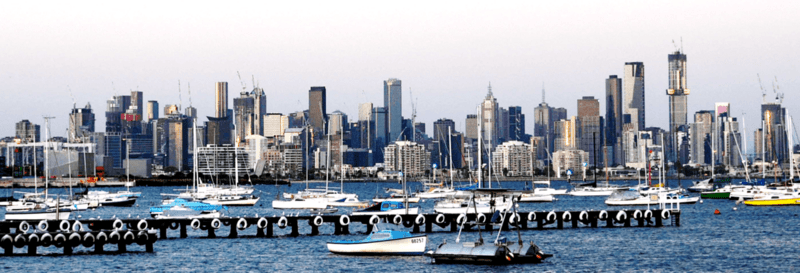
57 skyscrapers completed
1 skyscraper topped-out
3 skyscrapers under construction
15 skyscrapers completed
1 skyscraper under construction
1 skyscraper completed
1 skyscraper completed
1 skyscraper completed
1 skyscraper completed
1 skyscraper under construction
Overall
Melbourne has 77 skyscrapers completed or topped out within the city, which stand at least 150 metres (490 ft) tall, based on standard height measurement. Such measurement includes spires and architectural details, but does not include antenna masts. An equal sign (=) following a rank indicates the same height between two or more buildings. An asterisk (*) indicates that the building is still under construction, but has topped out. The "built" column indicates the year in which a building was completed. Height: S = Spire, R = Roof. Was Melbourne's tallest building when completed
| Rank | Name (Street address) |
Image | Height | Total floors | Built | Purpose | Location | Notes | |
|---|---|---|---|---|---|---|---|---|---|
| S | R | ||||||||
| 1 | Australia 108 (70 Southbank Boulevard) |
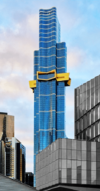 |
316.7 m (1,039 ft) |
100 | 2020 | Residential | Southbank 37°49′23″S 144°57′50″E / 37.82306°S 144.96389°E |
2nd-tallest building in Australia; tallest building in Australia to roof. First proposed in 2014, construction commenced in 2015. Completed in 2020. Tallest residential building in Australia to roof. First and only building in Melbourne to be designated a "supertall" skyscraper. First and only skyscraper in the Southern Hemisphere to comprise at least 100 floors. Tallest building completed during the 2020s. Tallest building within the Southbank precinct of Melbourne. Recognised in 7th place for the 2020 Emporis Skyscraper Award. | |
| 2 | Eureka Tower (7 Riverside Quay) |
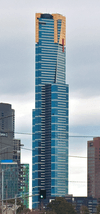 |
297.3 m (975 ft) |
91 | 2006 | Residential | Southbank 37°49′18″S 144°57′52″E / 37.82167°S 144.96444°E |
3rd-tallest building in Australia; 2nd-tallest building in Australia to roof. First proposed in 1999, construction commenced in 2001. Completed in 2006, it was the world's tallest residential tower when measured to its highest floor, until surpassed by Ocean Heights in Dubai, and the 35th–tallest building in the world overall. As of December 2016, it is the 15th-tallest residential building in the world. Tallest building in Australia to roof from 2006 to 2020. Tallest building completed during the 2000s. Recipient of the 2006 Bronze Emporis Skyscraper Award. | |
| 3 | Aurora Melbourne Central (250 La Trobe Street) |
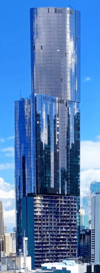 |
270.5 m (887 ft) |
85 | 2019 | Mixed use | City Centre 37°48′35.2″S 144°57′44.8″E / 37.809778°S 144.962444°E |
5th-tallest building in Australia; 5th-tallest building in Australia to roof. First proposed in 2014, construction commenced in 2015. Completed in 2019. Tallest building completed during the 2010s. Tallest building within the City Centre precinct of Melbourne. Recognised in 5th place for the 2019 Emporis Skyscraper Award. | |
| 4 | West Side Place Tower A (250 Spencer Street) | 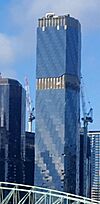 |
268.7 m (882 ft) |
81 | 2021 | Mixed use | City Centre 37°48′51.5″S 144°57′9.5″E / 37.814306°S 144.952639°E |
7th-tallest building in Australia; 7th-tallest building in Australia to roof. First proposed in 2013, construction commenced in 2017. Completed in 2021. Tallest building of the West Side Place complex. | |
| 5 | 120 Collins Street | 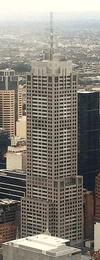 |
266.6 m (875 ft) |
222.2 m (729 ft) |
52 | 1991 | Office | City Centre 37°48′51.2″S 144°58′10.9″E / 37.814222°S 144.969694°E |
8th-tallest building in Australia. First proposed in 1986, construction commenced in 1989. Completed in 1991, it became the 27th–tallest building in the world, and the tallest building in Australia, until the completion of Q1 on the Gold Coast, Queensland in 2005. Tallest office building in Australia. Tallest building completed during the 1990s. |
| 6 | 101 Collins Street | 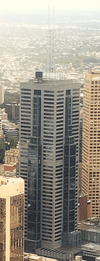 |
260 m (853 ft) |
195 m (640 ft) |
50 | 1991 | Office | City Centre 37°48′54″S 144°58′14.8″E / 37.81500°S 144.970778°E |
11th-tallest building in Australia. First proposed in 1987, construction commenced in 1988. Completed in 1991, it was the 33rd–tallest building in the world, and briefly reigned as the tallest building in Australia, until the completion of 120 Collins Street later in 1991. Tied 2nd-tallest office building in Australia. |
| 7 | Prima Pearl (31–49 Queensbridge Square) |
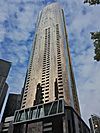 |
254 m (833 ft) |
72 | 2014 | Residential | Southbank 37°49′22.6″S 144°57′41.0″E / 37.822944°S 144.961389°E |
14th-tallest building in Australia; 12th-tallest building in Australia to roof. First proposed in 2004, construction commenced in 2012 and it was completed in 2014. | |
| 8 | Queens Place North Tower (350 Queen Street) |
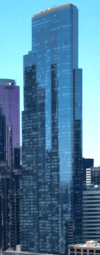 |
252.8 m (829 ft) |
79 | 2021 | Residential | City Centre 37°48′36″S 144°57′33″E / 37.81000°S 144.95917°E |
15th-tallest building in Australia. First proposed in 2015, construction commenced in 2018 before being completed in 2021. | |
| 9 | Rialto Towers (525 Collins Street) |
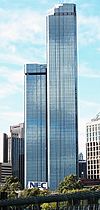 |
251.1 m (824 ft) |
63 | 1986 | Office | City Centre 37°49′7.4″S 144°57′26.9″E / 37.818722°S 144.957472°E |
17th-tallest building in Australia. First proposed in 1981, construction commenced in 1982. Completed in 1986, it became the tallest building in Australia and the 25th–tallest in the world, until the former title was surpassed by 101 Collins Street in 1991. It remained the tallest building in Australia to roof, until the completion of the Eureka Tower, in 2006. Tallest building completed during the 1980s. | |
| 10 | Victoria One (452 Elizabeth Street) |
 |
246.8 m (810 ft) |
76 | 2018 | Residential | City Centre 37°48′30.1″S 144°57′38.6″E / 37.808361°S 144.960722°E |
20th-tallest building in Australia; designed by Elenberg Fraser. First proposed in 2013, construction commenced in 2014, before being completed in 2018. | |
| 11 | Premier Tower (134–160 Spencer Street) |
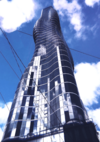 |
245.9 m (807 ft) |
78 | 2021 | Mixed use | City Centre 37°49′2.5″S 144°57′13.4″E / 37.817361°S 144.953722°E |
21st-tallest building in Australia; designed by Elenberg Fraser. First proposed in 2014, construction commenced in 2017, before topping–out in 2020. Completed in 2021. Recognised in 7th place for the 2021 Emporis Skyscraper Award. | |
| 12 | West Side Place Tower D (250 Spencer Street) |
239 m (784 ft) |
72 | 2023 | Residential | City Centre 37°48′50.5″S 144°57′11.7″E / 37.814028°S 144.953250°E |
27th-tallest building in Australia. First proposed in 2013, construction commenced in 2020, before topping–out in 2022. Second–tallest building of the West Side Place complex. | ||
| 13 | Swanston Central (168 Victoria Street) |
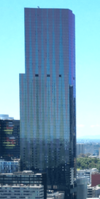 |
236.7 m (777 ft) |
71 | 2019 | Mixed use | Carlton 37°48′16.7″S 144°56′42.4″E / 37.804639°S 144.945111°E |
28th-tallest building in Australia. First proposed in 2015, construction commenced in 2016, before being completed 2019. Tallest building within the Carlton precinct of Melbourne, and only building to reach a height of 150 metres in this precinct. | |
| 14 | Shangri-La by the Gardens (308 Exhibition Street) |
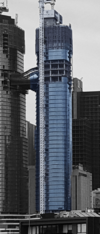 |
231.7 m (760 ft) |
59 | 2023 | Hotel | City Centre 37°48′29.9″S 144°58′9.6″E / 37.808306°S 144.969333°E |
30th-tallest building in Australia; designed by Fender Katsalidis Architects. First proposed in 2016, construction commenced in 2019, before topping-out in 2022. Upon completion in 2023, it will become the tallest all-hotel building in Australia, surpassing the Jewel Hotel on the Gold Coast. Taller tower of the by the Gardens development. | |
| 15 | Melbourne Square Tower 1 (93–119 Kavanagh Street) |
 |
231 m (758 ft) |
70 | 2021 | Residential | Southbank 37°49′33.5″S 144°57′48.4″E / 37.825972°S 144.963444°E |
31st-tallest building in Australia; designed by Cox Architecture. First proposed in 2017, construction commenced in 2018, before topping–out in 2020. Completed in 2021. Tallest building of the Melbourne Square complex. | |
| 16 | West Side Place Tower C (250 Spencer Street) |
230 m (755 ft) |
70 | 2023 | Residential | City Centre 37°48′52.1″S 144°57′12.5″E / 37.814472°S 144.953472°E |
Equal 32nd-tallest building in Australia. First proposed in 2013, construction commenced in 2020, before topping–out in 2022. 3rd–tallest building of the West Side Place complex. | ||
| 17 | Vision Apartments (500 Elizabeth Street) |
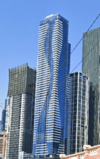 |
229 m (751 ft) |
70 | 2016 | Residential | City Centre 37°48′26″S 144°57′36.8″E / 37.80722°S 144.960222°E |
34th-tallest building in Australia. First proposed in 2011, construction commenced in 2013, before being completed in 2016. | |
| 18 = | 568 Collins Street | 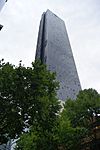 |
224 m (735 ft) |
68 | 2015 | Mixed use | City Centre 37°49′6.1″S 144°57′19.6″E / 37.818361°S 144.955444°E |
Equal 37th-tallest building in Australia. First proposed in 2011, construction commenced in 2012, before being completed in 2015. | |
| 18 = | Bourke Place (600 Bourke Street) |
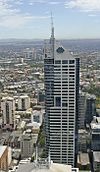 |
224 m (735 ft) |
49 | 1991 | Office | City Centre 37°48′57″S 144°57′21.7″E / 37.81583°S 144.956028°E |
Equal 37th-tallest building in Australia. Completed in 1991, it was the 89th–tallest building in the world. A communications mast sits atop the building, bringing its total height to tip to 254 metres (833 feet). |
|
| 20 | Sapphire by the Gardens (308 Exhibition Street) |
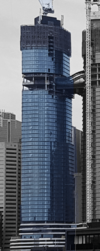 |
218.8 m (718 ft) |
57 | 2022 | Residential | City Centre 37°48′29.4″S 144°58′11.2″E / 37.808167°S 144.969778°E |
41st-tallest building in Australia; designed by Fender Katsalidis Architects. First proposed in 2016, construction commenced in 2019, before completion in 2022. Shorter tower of the by the Gardens development. | |
| 21 = | Light House Melbourne (450 Elizabeth Street) |
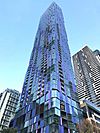 |
218 m (715 ft) |
69 | 2017 | Residential | City Centre 37°48′30.1″S 144°57′38.6″E / 37.808361°S 144.960722°E |
Equal 43rd-tallest building in Australia; designed by Elenberg Fraser. First proposed in 2013, construction commenced in 2015, before completion in 2017. | |
| 21 = | Telstra Corporate Centre (242 Exhibition Street) |
 |
218 m (715 ft) |
193 m (633 ft) |
47 | 1992 | Office | City Centre 37°48′34.1″S 144°58′10.9″E / 37.809472°S 144.969694°E |
Equal 43rd-tallest building in Australia. |
| 23 | 380 Melbourne (380 Lonsdale Street) |
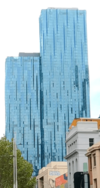 |
217.5 m (714 ft) |
67 | 2021 | Mixed use | City Centre 37°48′44.79″S 144°57′40.2″E / 37.8124417°S 144.961167°E |
46th-tallest building in Australia; designed by Elenberg Fraser. First proposed in 2014, construction commenced in 2018, before topping–out in 2020. Completed in 2021. | |
| 24 | Melbourne Central (350 Elizabeth Street) |
211 m (692 ft) |
53 | 1991 | Office | City Centre 37°48′39.2″S 144°57′43.2″E / 37.810889°S 144.962000°E |
50th-tallest building in Australia. Construction commenced in 1989, and was completed in 1991. Twin communications masts sit atop the building, bringing its total height to tip to 246 metres (807 feet). |
||
| 25 | Aspire Melbourne (299 King Street) |
210.6 m (691 ft) |
65 | 2023 | Residential | City Centre 37°48′48.2″S 144°57′14.4″E / 37.813389°S 144.954000°E |
First proposed in 2014, construction commenced in 2020, before topping–out in 2022. | ||
| 26 | UNO Melbourne (111 A'Beckett Street) |
210 m (689 ft) |
65 | 2023 | Residential | City Centre 37°48′34.7″S 144°57′36.5″E / 37.809639°S 144.960139°E |
First proposed in 2015, construction began in 2020. | ||
| 27 | West Side Place Tower B (250 Spencer Street) |
 |
206 m (676 ft) |
65 | 2021 | Mixed use | City Centre 37°48′51.5″S 144°57′8.9″E / 37.814306°S 144.952472°E |
First proposed in 2013, construction commenced in 2017, before topping–out in 2020. Completed in 2021. 4th–tallest building of the West Side Place complex. | |
| 28 | Freshwater Place North (1 Queensbridge Square) |
205 m (673 ft) |
63 | 2005 | Residential | Southbank 37°49′18.7″S 144°57′41.5″E / 37.821861°S 144.961528°E |
Construction commenced in 2002, and the building was completed in 2005. | ||
| 29 | Eq. Tower (127–141 A'Beckett Street) |
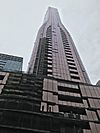 |
202 m (663 ft) |
63 | 2017 | Residential | City Centre 37°48′35.1″S 144°57′34.8″E / 37.809750°S 144.959667°E |
Designed by Elenberg Fraser. First proposed in 2014, construction commenced in 2015, with a 2017 completion date. | |
| 30 | Empire Melbourne (398 Elizabeth Street) |
198.4 m (651 ft) |
62 | 2017 | Mixed use | City Centre 37°48′33.8″S 144°57′40.3″E / 37.809389°S 144.961194°E |
Designed by Hayball Architecture. First proposed in 2014, construction commenced in 2015. Completed in 2017. | ||
| 31 = | Home Southbank (258 City Road) |
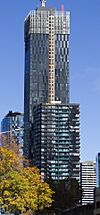 |
198 m (650 ft) |
60 | 2022 | Residential | Southbank 37°49′18.7″S 144°57′57.1″E / 37.821861°S 144.965861°E |
First proposed in 2013, construction commenced in 2019. Completed in 2022. | |
| 31 = | Melbourne Grand (556–558 Lonsdale Street) |
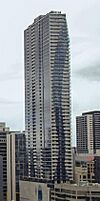 |
198 m (650 ft) |
57 | 2020 | Residential | City Centre 37°48′50.5″S 144°57′21.1″E / 37.814028°S 144.955861°E |
Designed by Central Equity. First proposed in 2015, construction commenced in 2018. Completed in 2020. | |
| 33 | Collins House (466 Collins Street) |
190 m (623 ft) |
59 | 2019 | Residential | City Centre 37°49′3.25″S 144°57′31.1″E / 37.8175694°S 144.958639°E |
Designed by Bates Smart. First proposed in 2013, construction commenced in 2017. Completed in 2019. Recipient of an "Award of Excellence" for the 2021 CTBUH Skyscraper Awards in the category "Construction". | ||
| 34 | 80 Collins South (80 Collins Street) |
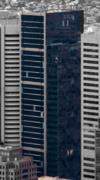 |
188.4 m (618 ft) |
41 | 2020 | Office | City Centre 37°48′50.6″S 144°58′14.7″E / 37.814056°S 144.970750°E |
First proposed in 2016, construction commenced in 2017. Completed in 2020. Recipient of an "Award of Excellence" for the 2021 CTBUH Skyscraper Awards in the category "Structural Engineering". | |
| 35 = | Sofitel Hotel at Collins Place (35 Collins Street) |
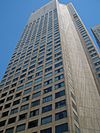 |
188 m (617 ft) |
50 | 1980 | Mixed use | City Centre 37°48′50″S 144°58′22.9″E / 37.81389°S 144.973028°E |
Construction commenced in 1978, and it was completed in 1980. It became the city's tallest building (equal with ANZ Tower at Collins Place), until it was surpassed by the Rialto Towers in 1986. | |
| 35 = | ANZ Tower at Collins Place (55 Collins Street) |
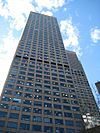 |
188 m (617 ft) |
46 | 1978 | Office | City Centre 37°48′51.6″S 144°58′20.6″E / 37.814333°S 144.972389°E |
First proposed in 1970, construction commenced in 1973, and it was completed in 1978. It became the city's tallest building and the 93rd–tallest building in the world overall, with the former title equaled by the Sofitel Hotel in 1980, also at Collins Place. Tallest building completed during the 1970s. | |
| 35 = | Meriton Suites (140 King Street) |
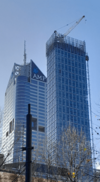 |
188 m (617 ft) |
58 | 2023 | Residential | City Centre 37°49′0.3″S 144°57′22.2″E / 37.816750°S 144.956167°E |
First proposed in 2015, construction began in 2020. | |
| 38 | Abode318 (312–318 Russell Street) |
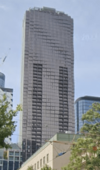 |
187.3 m (615 ft) |
57 | 2015 | Residential | City Centre 37°48′33.2″S 144°58′0.3″E / 37.809222°S 144.966750°E |
Designed by Elenberg Fraser. First proposed in 2007, construction commenced in 2011. Completed in 2015. Recognised in 5th place for the 2015 Emporis Skyscraper Award. | |
| 39 | 80 Collins Street |  |
182 m (597 ft) |
54 | 1977 | Office | City Centre 37°48′50.6″S 144°58′14.7″E / 37.814056°S 144.970750°E |
Completed in 1977, it briefly became the city's tallest building, until it was surpassed by the ANZ Tower at Collins Place in 1978. Also known as Nauru House. | |
| 40 | Victoria Police Centre Tower 2 (311 Spencer Street) |
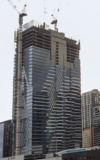 |
180 m (591 ft) |
40 | 2020 | Office | Docklands 37°49′4.8″S 144°57′12.9″E / 37.818000°S 144.953583°E |
Construction commenced in 2017, and was completed in 2020. Tallest building within the Docklands precinct of Melbourne, and only building to reach a height of 150 metres in this precinct. | |
| 41 | Melbourne Square Tower 2 (93–119 Kavanagh Street) |
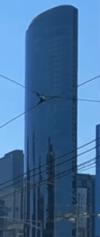 |
179 m (587 ft) |
59 | 2021 | Mixed use | Southbank 37°49′33.3″S 144°57′50.4″E / 37.825917°S 144.964000°E |
Designed by Cox Architecture. First proposed in 2014, construction commenced in 2018, before topping–out in 2020. Completed in 2021. Currently 2nd–tallest building of the Melbourne Square complex. | |
| 42 | Capitol Grand (241 Toorak Road) |
 |
178 m (584 ft) |
50 | 2019 | Residential | South Yarra 37°50′21.3″S 144°59′42.7″E / 37.839250°S 144.995194°E |
First proposed in 2011, construction commenced in 2017; having topped–out in 2019, the project was completed in late 2019. Tallest building within the South Yarra precinct of Melbourne, and only building to reach a height of 150 metres in this precinct. | |
| 43 | Scape on Franklin (97 Franklin Street) |
175 m (574 ft) |
55 | 2021 | Mixed use | City Centre 37°48′29″S 144°57′40″E / 37.80806°S 144.96111°E |
First proposed in 2014, construction commenced in 2018. Completed in 2021. | ||
| 44 = | MY80 (410 Elizabeth Street) |
173 m (568 ft) |
55 | 2014 | Residential | City Centre 37°48′32.3″S 144°57′39.6″E / 37.808972°S 144.961000°E |
Designed by Hayball Architecture. First proposed in 2010, construction commenced in 2011, before being completed in 2014. | ||
| 44 = | 405 Bourke Street | 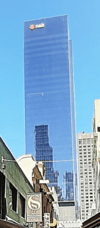 |
173 m (568 ft) |
39 | 2021 | Office | City Centre 37°48′54″S 144°57′43″E / 37.81500°S 144.96194°E |
First proposed in 2009, construction commenced in 2018. Completed in 2021. | |
| 46 | Avant (54 A'Beckett Street) |
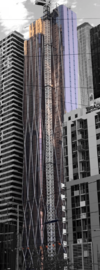 |
172 m (564 ft) |
55 | 2018 | Residential | City Centre 37°48′31.8″S 144°57′41.9″E / 37.808833°S 144.961639°E |
Designed by Elenberg Fraser. First proposed in 2015, construction commenced in 2016, before being completed in 2018. | |
| 47 | Upper West Side Tower 5 (33 Rose Lane) |
170 m (558 ft) |
53 | 2016 | Residential | City Centre 37°48′53.6″S 144°57′14.1″E / 37.814889°S 144.953917°E |
Tallest building of the Upper West Side complex. Building also referred to as 'Manhattan'. First proposed in 2011, construction commenced in 2013, before being completed in 2016. | ||
| 48 | 385 Bourke Street | 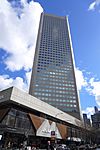 |
169 m (554 ft) |
43 | 1983 | Office | City Centre 37°48′53.1″S 144°57′46.3″E / 37.814750°S 144.962861°E |
Designed by Norman Disney & Young | |
| 49 | Olderfleet (477 Collins Street) |
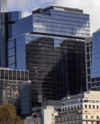 |
168 m (551 ft) |
40 | 2020 | Office | City Centre 37°49′5″S 144°57′30″E / 37.81806°S 144.95833°E |
First proposed in 2015, construction commenced in 2017. Completed in 2020. Designed by Grimshaw Architects. Recipient of two "Awards of Excellence" for the 2022 CTBUH Skyscraper Awards in the categories "Best Tall Building 100-199 meters" and "Best Tall Office Building". | |
| 50 | Zen Apartments (27 Therry Street) |
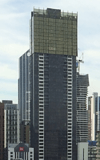 |
167.8 m (551 ft) |
50 | 2012 | Residential | City Centre 37°48′25″S 144°57′39.8″E / 37.80694°S 144.961056°E |
Designed by Urban Design Architects. First proposed in 2008, construction commenced in 2009, before being completed in 2012. | |
| 51 = | Platinum Tower One (245–263 City Road) |
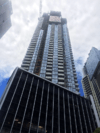 |
167 m (548 ft) |
52 | 2016 | Residential | Southbank 37°49′36.5″S 144°57′33.9″E / 37.826806°S 144.959417°E |
Designed by Squillace. First proposed in 2011, construction commenced in 2014, before being completed in 2016. | |
| 51 = | 530 Collins Street | 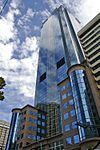 |
167 m (548 ft) |
40 | 1991 | Office | City Centre 37°49′4″S 144°57′24.4″E / 37.81778°S 144.956778°E |
Designed by Peddle Thorp Architects | |
| 53 = | Southbank Place (54–68 Kavanagh Street) |
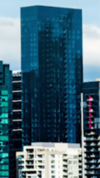 |
166 m (545 ft) |
52 | 2019 | Residential | Southbank 37°49′27.5″S 144°57′49.4″E / 37.824306°S 144.963722°E |
Construction commenced in 2016; having topped–out in late 2018, the project was completed in 2019. Designed by Guildford Bell & Graham Fisher. | |
| 53 = | Focus Melbourne (71–87 City Road) |
166 m (545 ft) |
50 | 2022 | Residential | Southbank 37°49′20″S 144°57′55.8″E / 37.82222°S 144.965500°E |
First proposed in 2015, construction commenced in 2020, before topping–out in 2022. Completed in 2022. | ||
| 53 = | Casselden Place (2 Lonsdale Street) |
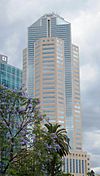 |
166 m (545 ft) |
43 | 1992 | Office | City Centre 37°48′33.5″S 144°58′17.6″E / 37.809306°S 144.971556°E |
Designed by HASSELL | |
| 56 | The Fifth (605–613 Lonsdale Street) |
165.5 m (543 ft) |
51 | 2017 | Residential | City Centre 37°48′56″S 144°57′11″E / 37.81556°S 144.95306°E |
Second tallest building of the Upper West Side complex. First proposed in 2014, construction commenced in 2015. Completed in 2017. | ||
| 57 | Ernst & Young Tower (8 Exhibition Street) |
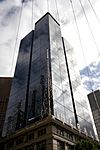 |
164.7 m (540 ft) |
40 | 2005 | Mixed use | City Centre 37°48′55.4″S 144°58′22″E / 37.815389°S 144.97278°E |
Designed by Denton Corker Marshall. First proposed in 2001, construction commenced in 2003. Completed in 2005. | |
| 58 | 35 Spring Street |  |
164.4 m (539 ft) |
44 | 2017 | Residential | City Centre 37°48′51″S 144°58′26.5″E / 37.81417°S 144.974028°E |
First proposed in 2013, construction commenced in 2014. Completed in 2017. | |
| 59 | SX Stage 1 (121 Exhibition Street) |
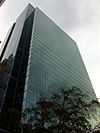 |
163 m (535 ft) |
40 | 2005 | Office | City Centre 37°48′45.4″S 144°58′13.2″E / 37.812611°S 144.970333°E |
Designed by Woods Bagot Melbourne. Construction commenced in 2003, and it was completed in 2005. | |
| 60 = | Royal Domain Tower (368 St Kilda Road) |
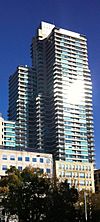 |
162 m (531 ft) |
46 | 2005 | Residential | St Kilda Road 37°49′54.2″S 144°58′16.3″E / 37.831722°S 144.971194°E |
Construction commenced in 2003, and it was completed in 2005. Designed by Meinhardt Group. Tallest building within the St Kilda Road precinct of Melbourne, and only building to reach a height of 150 metres in this precinct. | |
| 60 = | 100 Queen Street (Former ANZ World Headquarters) |
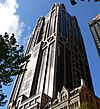 |
162 m (531 ft) |
37 | 1993 | Office | City Centre 37°48′59.7″S 144°57′42.3″E / 37.816583°S 144.961750°E |
Designed by Peddle Thorp Architects | |
| 62 = | Unilodge Place (478-488 Elizabeth Street) |
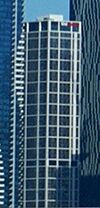 |
161 m (528 ft) |
52 | 2021 | Residential | City Centre 37°48′28″S 144°57′38″E / 37.80778°S 144.96056°E |
Construction began in 2019 and completed in 2021. | |
| 62 = | National Bank House (500 Bourke Street) |
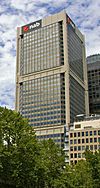 |
161 m (528 ft) |
40 | 1978 | Office | City Centre 37°48′54.4″S 144°57′31.6″E / 37.815111°S 144.958778°E |
In 2009, the building was fully refurbished by then owner ISPT in order to increase energy efficiency to 5 stars | |
| 64 | 2 Southbank Boulevard | 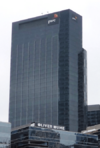 |
160.8 m (528 ft) |
40 | 2005 | Office | Southbank 37°49′17.5″S 144°57′44.8″E / 37.821528°S 144.962444°E |
Designed by Bates Smart. Construction commenced in 2002, and it was completed in 2005. | |
| 65 | Verve 501 Swanston Tower (501 Swanston Street) |
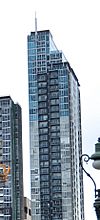 |
159 m (522 ft) |
45 | 2006 | Mixed use | City Centre 37°48′24.8″S 144°57′42.4″E / 37.806889°S 144.961778°E |
Designed by Urban Design Architects. Construction commenced in 2004, and it was completed in 2006. | |
| 66 | Wesley Place (130 Lonsdale Street) |
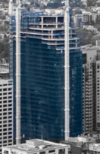 |
156.5 m (513 ft) |
35 | 2020 | Office | City Centre 37°48′42.6″S 144°57′48.9″E / 37.811833°S 144.963583°E |
First proposed in 2016, construction commenced in 2017. Completed in 2020. Designed by Cox Architecture. Recipient of three "Awards of Excellence" for the 2022 CTBUH Skyscraper Awards in the categories "Best Tall Building 100-199 meters", "Best Tall Office Building", and "Urban Habitat - District/Master Plan Scale". | |
| 67 = | Upper West Side Tower 2 (Lonsdale Street) |
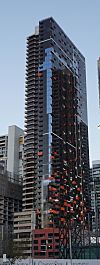 |
156 m (512 ft) |
50 | 2014 | Residential | City Centre 37°48′54.5″S 144°57′14″E / 37.815139°S 144.95389°E |
3rd-tallest building of the Upper West Side complex. Building also referred to as 'Madison'. Construction commenced in 2011, and it was completed in 2014. | |
| 67 = | Palladium Tower (251 City Road) |
156 m (512 ft) |
47 | 2020 | Residential | Southbank 37°49′20.0″S 144°57′52.7″E / 37.822222°S 144.964639°E |
First proposed in 2017, construction commenced in 2018. Completed in 2020. | ||
| 69 | Paragon (318 Queen Street) |
155 m (509 ft) |
48 | 2021 | Residential | City Centre 37°48′40.7″S 144°57′33.5″E / 37.811306°S 144.959306°E |
First proposed in 2017, construction commenced in 2018, and was completed in 2021. | ||
| 70 | 183–189 A'Beckett Street | 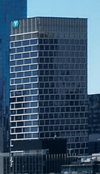 |
154 m (505 ft) |
48 | 2021 | Residential | City Centre 37°48′47″S 144°57′29″E / 37.81306°S 144.95806°E |
First proposed in 2015, construction commenced in 2019, and was completed in 2021. | |
| 71 = | Shadow Play (105 Clarendon Street) |
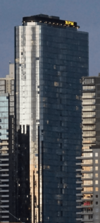 |
153 m (502 ft) |
52 | 2018 | Residential | Southbank 37°49′37.5″S 144°57′29.2″E / 37.827083°S 144.958111°E |
First proposed in 2015, construction commenced in 2015. Completed in 2018. | |
| 71 = | Southbank Central (1–11 Balston Street) |
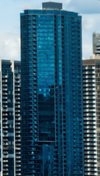 |
153 m (502 ft) |
48 | 2017 | Residential | Southbank 37°49′30.6″S 144°57′41.1″E / 37.825167°S 144.961417°E |
First proposed in 2014, construction commenced in 2015. Completed in 2017. | |
| 71 = | Optus Centre (367 Collins Street) |
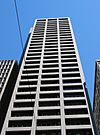 |
153 m (502 ft) |
34 | 1975 | Office | City Centre 37°49′1.8″S 144°57′44.7″E / 37.817167°S 144.962417°E |
Completed in 1975, it became the city's tallest building, until it was surpassed by Nauru House in 1977. | |
| 74 = | Crown Towers (8 Whiteman Street) |
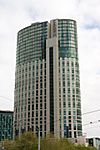 |
152.5 m (500 ft) |
43 | 1997 | Hotel | Southbank 37°49′20.4″S 144°57′37.3″E / 37.822333°S 144.960361°E |
Tallest of three Crown hotels in Melbourne. Upon completion in 1997, it was the tallest all-hotel building in Australia; a record it held until the completion of the Jewel Hotel on the Gold Coast, in 2019. Designed by Hudson Conway Architects and Daryl Jackson. | |
| 74 = | 140 William Street | 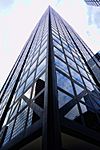 |
152.5 m (500 ft) |
41 | 1972 | Office | City Centre 37°48′57″S 144°57′31.8″E / 37.81583°S 144.958833°E |
Construction commenced in 1969; completed in 1972, it became the city's tallest building, until it was surpassed by Optus Centre in 1975, by 50 centimetres. Recipient of the RVIA Victorian Architects award in 1975. | |
| 76 | 555 Collins Street | 152 m (499 ft) |
35 | 2023 | Office | City Centre 37°49′7.29″S 144°57′22.6″E / 37.8186917°S 144.956278°E |
Construction began in 2020. | ||
| 77 | Urban Workshop Lonsdale (50 Lonsdale Street) |
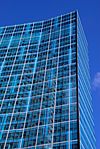 |
150 m (492 ft) |
34 | 2005 | Office | City Centre 37°48′33.4″S 144°58′14.4″E / 37.809278°S 144.970667°E |
Designed by Hassell, John Wardle Architects and B+N Group | |
Tallest buildings by precinct
This lists the tallest building in each precinct of Melbourne based on standard height measurement.
| Rank | Name | Height | Floors | Precinct of Melbourne |
Completion | |
|---|---|---|---|---|---|---|
| List | ||||||
| 1 | 1 | Australia 108 | 316.7 m (1,039 ft) | 100 | Southbank | 2020 |
| 2 | 3 | Aurora Melbourne Central | 270.5 m (887 ft) | 85 | City Centre | 2019 |
| 3 | 13 | Swanston Central | 236.7 m (777 ft) | 71 | Carlton | 2019 |
| 4 | 40 | Victoria Police Centre Tower 2 | 180 m (591 ft) | 40 | Docklands | 2020 |
| 5 | 42 | Capitol Grand | 178 m (584 ft) | 52 | South Yarra | 2019 |
| 6 | 60 (=) | Royal Domain Tower | 162 m (531 ft) | 43 | St Kilda Road | 2005 |
| 7 | — | Fifty Albert | 98.1 m (322 ft) | 30 | South Melbourne | 2013 |
Tallest buildings by function
This lists the tallest buildings in Melbourne by their respective functions—office, hotel, residential and mixed-use—based on standard height measurement.
| Rank | Name | Height | Floors | Function | Completion | |
|---|---|---|---|---|---|---|
| List | ||||||
| 1 | 1 | Australia 108 | 316.7 m (1,039 ft) | 100 | Residential | 2020 |
| 3 | 3 | Aurora Melbourne Central | 270.5 m (887 ft) | 85 | Mixed use | 2019 |
| 2 | 5 | 120 Collins Street | 266.6 m (875 ft) | 52 | Office | 1991 |
| 4 | 74 (=) | Crown Towers | 152.5 m (500 ft) | 43 | Hotel | 1997 |
Skyscrapers at least 200 metres in height
Melbourne comprises 29 skyscrapers (completed or topped-out) which reach a height of at least 200 metres (660 ft)—more than any other city within Australia and Oceania. Of those, twenty-three skyscrapers are located within the City Centre, five are located within Southbank, and one in Carlton.
| List of skyscrapers which stand at least 200 metres in height | |||||
|---|---|---|---|---|---|
| Rank | Building | Height | Built | Location | |
| 1 | Australia 108 | 316.7 m (1,039 ft) | 2020 | Southbank | |
| 2 | Eureka Tower | 297.3 m (975 ft) | 2006 | Southbank | |
| 3 | Aurora Melbourne Central | 270.5 m (887 ft) | 2019 | City Centre | |
| 4 | West Side Place Tower A | 268.7 m (882 ft) | 2021 | City Centre | |
| 5 | 120 Collins Street | 266.6 m (875 ft) | 1991 | City Centre | |
| 6 | 101 Collins Street | 260 m (850 ft) | 1991 | City Centre | |
| 7 | Prima Pearl | 254 m (833 ft) | 2014 | Southbank | |
| 8 | Queens Place North Tower | 252.8 m (829 ft) | 2021 | City Centre | |
| 9 | Rialto Towers | 251.1 m (824 ft) | 1986 | City Centre | |
| 10 | Victoria One | 246.8 m (810 ft) | 2018 | City Centre | |
| 11 | Premier Tower | 245.9 m (807 ft) | 2021 | City Centre | |
| 12 | West Side Place Tower D | 239 m (784 ft) | 2023 | City Centre | |
| 13 | Swanston Central | 236.7 m (777 ft) | 2019 | Carlton | |
| 14 | Shangri-La by the Gardens | 231.7 m (760 ft) | 2023 | City Centre | |
| 15 | Melbourne Square Tower 1 | 231 m (758 ft) | 2021 | Southbank | |
| 16 | West Side Place Tower C | 230 m (750 ft) | 2023 | City Centre | |
| 17 | Vision Apartments | 229 m (751 ft) | 2016 | City Centre | |
| 18 | 568 Collins Street | 224 m (735 ft) | 2015 | City Centre | |
| Bourke Place | 224 m (735 ft) | 1991 | City Centre | ||
| 20 | Sapphire by the Gardens | 218.8 m (718 ft) | 2022 | City Centre | |
| 21 | Light House Melbourne | 218 m (715 ft) | 2017 | City Centre | |
| Telstra Corporate Centre | 218 m (715 ft) | 1992 | City Centre | ||
| 23 | 380 Melbourne | 217.5 m (714 ft) | 2021 | City Centre | |
| 24 | West Side Place Tower B | 211 m (692 ft) | 2021 | City Centre | |
| Melbourne Central | 211 m (692 ft) | 1991 | City Centre | ||
| 26 | Aspire Melbourne | 210.6 m (691 ft) | 2023 | City Centre | |
| 27 | 435 Bourke Street | 210.3 m (690 ft) | 2025 | City Centre | |
| 28 | UNO Melbourne | 210 m (690 ft) | 2023 | City Centre | |
| 29 | The Queensbridge | 209 m (686 ft) | 2025 | Southbank | |
| 30 | Freshwater Place North | 205 m (673 ft) | 2005 | Southbank | |
| 31 | EQ Tower | 202 m (663 ft) | 2017 | City Centre | |
Timeline of tallest buildings
This lists buildings that once held the title of "tallest building in Melbourne".
| Name | Image | Years as tallest | Height | Floors | Notes |
|---|---|---|---|---|---|
| Kew Asylum |  |
1871–1876 | 30 m (98 ft) | 5 | |
| Yorkshire Brewery Tower | 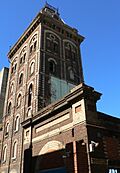 |
1876–1888 | 34 m (112 ft) | 8 | |
| Fink's Building | 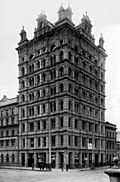 |
1888 | 43 m (141 ft) | 10 | Partially demolished in 1897 due to fire |
| Federal Coffee Palace | 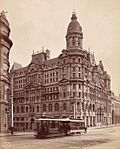 |
1888-1890 | 50.292 m (165.00 ft) | 9 | Height to roof (7 storeys) 47.5 m (156 ft) (to tower additional 2 storeys) 50.292 m (165.00 ft). Demolished in 1972 |
| The Australian Building | 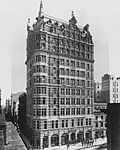 |
1890–1932 | 53 m (174 ft) | 12 | Tallest building in Australia (1890–1912). Demolished in 1980 |
| Manchester Unity Building | 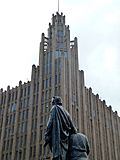 |
1932–1958 | 64 m (210 ft) | 13 | |
| Orica House | 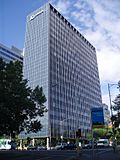 |
1958–1962 | 81 m (266 ft) | 20 | Tallest building in Australia (1958–1961) |
| CRA Building | 1962–1969 | 99 m (325 ft) | 26 | Demolished in 1988 | |
| AMP Square | 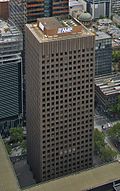 |
1969–1971 | 113.4 m (372 ft) | 28 | |
| Marland House |  |
1971–1972 | 121 m (397 ft) | 32 | |
| 140 William Street | 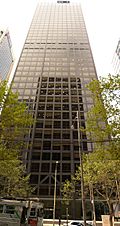 |
1972–1975 | 152.5 m (500 ft) | 41 | |
| Optus Centre | 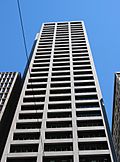 |
1975–1977 | 153 m (502 ft) | 34 | |
| Nauru House | 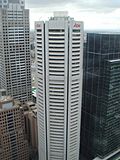 |
1977–1978 | 182 m (597 ft) | 52 | |
| ANZ Tower at Collins Place |  |
1978–1986 | 188 m (617 ft) | 56 | Equal–tallest building in Melbourne with Sofitel Hotel at Collins Place from 1980 to 1986 |
| Sofitel Hotel at Collins Place |  |
1980–1986 | 188 m (617 ft) | 50 | Equal–tallest building in Melbourne with ANZ Tower at Collins Place |
| Rialto Towers | 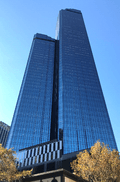 |
1986–1991 | 251.1 m (824 ft) | 63 | Tallest building in Australia (1986–1991), tallest building in Australia to roof (1986–2006) |
| 101 Collins Street | 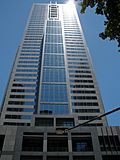 |
1991 | 260 m (850 ft) | 50 | Tallest building in Australia (1991) |
| 120 Collins Street | 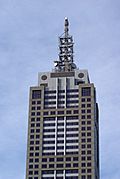 |
1991–2006 | 266.6 m (875 ft) | 52 | Tallest building in Australia (1991–2005) |
| Eureka Tower |  |
2006–2020 | 297.3 m (975 ft) | 91 | Tallest building in Australia to roof (2006–2020) |
| Australia 108 | 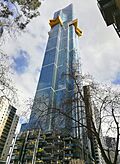 |
2020–present | 316.7 m (1,039 ft) | 100 | Tallest building in Australia to roof (2020–present) |
Future skyscrapers
This is a list of currently topped out, under construction, approved and proposed skyscrapers set for Melbourne.
| Topped out | Under construction | On hold | Approved | Proposed |
| Name | Height | Floors | Purpose | Precinct of Melbourne |
Estimated completion |
Status | |
|---|---|---|---|---|---|---|---|
| m | ft | ||||||
| Southbank by Beulah Tower 1 | 366 | 1,201 | 102 | Residential | Southbank | TBA | Approved |
| 25–35 Power Street | 280.3 | 920 | 71 | Mixed use | Southbank | TBA | Approved |
| Southbank by Beulah Tower 2 | 273 | 896 | 72 | Mixed use | Southbank | TBA | Approved |
| Queens Place South Tower | 251 | 823 | 79 | Residential | City Centre | TBA | Approved |
| 640 Bourke Street | 234.6 | 770 | 68 | Mixed use | City Centre | TBA | Approved |
| 51–65 Clarke Street | 233 | 764 | 70 | Residential | Southbank | TBA | Approved |
| 295 City Road | 228 | 748 | 70 | Residential | Southbank | TBA | Approved |
| 303 La Trobe Street | 213 | 699 | 66 | Residential | City Centre | TBA | Approved |
| Aspire Melbourne | 210.6 | 691 | 65 | Residential | City Centre | 2023 | Topped out |
| 435 Bourke Street | 210.3 | 690 | 49 | Office | City Centre | 2025 | Under construction |
| UNO Melbourne | 210 | 690 | 65 | Residential | City Centre | 2023 | Topped out |
| The Queensbridge | 209 | 686 | 66 | Residential | Southbank | 2025 | Under construction |
| 280 Queen Street | 207 | 679 | 68 | Residential | City Centre | TBA | Proposed |
| 334–344 City Road | 190 | 620 | 58 | Residential | Southbank | TBA | Approved |
| 268–274 City Road | 187 | 614 | 55 | Residential | Southbank | TBA | Approved |
| 600 Collins | 182 | 597 | 47 | Office | City Centre | 2026 | Under construction |
| 60–82 Johnson Street Tower 1A | 181 | 594 | 53 | Residential | South Melbourne | TBA | Approved |
| 60–82 Johnson Street Tower 2B | 181 | 594 | 53 | Residential | South Melbourne | TBA | Approved |
| Melbourne Square Tower 5 | 180 | 590 | 54 | Hotel | Southbank | TBA | Approved |
| Sol Invictus Tower | 178 | 584 | 51 | Residential | Southbank | TBA | Proposed |
| 96–102 Franklin Street | 177 | 581 | 57 | Residential | City Centre | TBA | Proposed |
| 212–222 La Trobe Street North Tower | 176 | 577 | 56 | Residential | City Centre | TBA | Approved |
| Melbourne Square Tower 3 | 175 | 574 | 56 | Residential | Southbank | TBA | Approved |
| Melbourne Square Tower 4 | 175 | 574 | 56 | Residential | Southbank | TBA | Approved |
| 52–60 Collins Street | 163.1 | 535 | 40 | Office | City Centre | TBA | Approved |
| Melbourne Quarter West Tower | 160 | 520 | 37 | Office | Docklands | 2024 | Under construction |
| 56-62 Clarendon Street | 159.7 | 524 | 49 | Residential | Southbank | TBA | Approved |
| 32 Flinders Street | 158.5 | 520 | 41 | Office | City Centre | 2025 | Under construction |
| 57 Haig Street | 155.7 | 511 | 47 | Residential | Southbank | TBA | Approved |
| 277-281 Ingles Street | 155 | 509 | 51 | Residential | Port Melbourne | TBA | Approved |
| 56-62 Clarendon Street | 155 | 509 | 40 | Office | City Centre | TBA | Approved |
| 87–105 Queensbridge Tower 1 | 152.9 | 502 | 47 | Mixed use | Southbank | TBA | Proposed |
| 87–105 Queensbridge Tower 2 | 152.9 | 502 | 47 | Mixed use | Southbank | TBA | Proposed |
| 555 Collins Street | 152 | 499 | 35 | Office | City Centre | 2023 | Topped out |
| 85–93 Lorimer Street Tower 1 | 150 | 490 | 49 | Residential | Docklands | TBA | Approved |
Major cancelled, revised, or vision projects
This is a list of cancelled, revised or vision skyscraper proposals that were previously set for Melbourne.
| Revised | Cancelled | Vision |
| Name | Height | Floors | Purpose | Precinct of Melbourne |
Proposed | Status | |
|---|---|---|---|---|---|---|---|
| m | ft | ||||||
| Grollo Tower | 680 | 2,230 | 137 | Mixed use | Docklands | 1997 | Cancelled |
| South Pacific Centre | 610 | 2,000 | 150 | Mixed use | Docklands | — | Vision |
| Grollo Tower | 560 | 1,840 | 113 | Mixed use | Docklands | 2001 | Cancelled |
| 555 Collins Street | 404 | 1,325 | 82 | Office | City Centre | 2013 | Revised |
| Australia 108 | 388 | 1,273 | 108 | Mixed use | Southbank | 2012 | Revised |
| Victoria Central Tower | 380 | 1,250 | 80 | Mixed use | City Centre | — | Cancelled |
| Urban Tree | 360 | 1,180 | TBC | Mixed use | Southbank | 2018 | Vision |
| The Lanescraper | 359.6 | 1,180 | TBC | Mixed use | Southbank | 2018 | Vision |
| Stack | 359 | 1,178 | TBC | Mixed use | Southbank | 2018 | Vision |
| The Base | 345 | 1,132 | TBC | Mixed use | Southbank | 2018 | Vision |
| Melbourne Plaza | 338 | 1,109 | 53 | Office | City Centre | — | Cancelled |
| The Beulah Propeller City | 335 | 1,099 | TBC | Mixed use | Southbank | 2018 | Vision |
| Magic | 330 | 1,080 | 60 | Residential | Carlton | 2018 | Vision |
| One Queensbridge | 323.6 | 1,062 | 90 | Mixed use | Southbank | 2015 | Cancelled |
| Queensbridge Tower | 308 | 1,010 | 84 | Mixed use | Southbank | 2011 | Revised |
| 555 Collins Street | 302 | 991 | 82 | Mixed use | City Centre | 2014 | Revised |
| 433–455 Collins Street | 300 | 980 | – | Mixed use | City Centre | 2014 | Cancelled |
| Premier Tower | 294 | 965 | 90 | Mixed use | City Centre | 2014 | Revised |
| 280 Queen Street | 251.8 | 826 | 80 | Residential | City Centre | 2014 | Vision |
| Elysium | 243.8 | 800 | 75 | Residential | Southbank | 2011 | Vision |
| 383 La Trobe Street | 242 | 794 | 70 | Mixed use | City Centre | 2016 | Vision |
| Tower Melbourne | 226 | 741 | 71 | Residential | City Centre | 2012 | Cancelled |
| 582–606 Collins Street | 185.5 | 609 | 54 | Mixed use | City Centre | 2015 | Vision |
| 32 Flinders Street | 174 | 571 | 54 | Residential | City Centre | TBA | Vision |
| 447 Collins Street Twin Towers 1 | 165 | 541 | 47 | Office | City Centre | 2015 | Revised |
| 447 Collins Street Twin Towers 2 | 165 | 541 | 47 | Office | City Centre | 2015 | Revised |
See also
 In Spanish: Anexo:Edificios más altos de Melbourne para niños
In Spanish: Anexo:Edificios más altos de Melbourne para niños
- Architecture of Melbourne
- List of tallest buildings in Australia
- List of tallest buildings in Oceania


